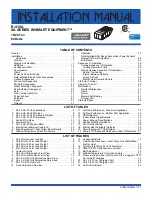
2
103868
PROPANE CONSTRUCTION HEATER
50,000 BTU/HR
SAFETY
INFORMATION
WARNING: FIRE, BURN, IN-
HALATION, AND EXPLOSION
HAZARD. KEEP SOLID COMBUS-
TIBLES, SUCH AS BUILDING MA-
TERIALS, PAPER OR CARD-
BOARD, A SAFE DISTANCE
AWAY FROM THE HEATER AS
RECOMMENDED BY THE IN-
STRUCTIONS. NEVER USE THE
HEATER IN SPACES WHICH DO
OR MAY CONTAIN VOLATILE OR
AIRBORNE COMBUSTIBLES, OR
PRODUCTS SUCH AS GASO-
LINE, SOLVENTS, PAINT THIN-
NER, DUST PARTICLES OR UN-
KNOWN CHEMICALS.
WARNING: NOT FOR HOME
OR RECREATIONAL VEHICLE
USE.
The heater is designed for use as a construc-
tion heater in accordance with ANSI Z83.7/
CGA 2.14. Other standards govern the use
of fuel gases and heating products for spe-
cific uses. Your local authority can advise
you about these. The primary purpose of
construction heaters is to provide temporary
heating of buildings under construction, al-
teration or repair. Properly used, the heater
provides safe economical heating. Products
of combustion are vented into the area being
heated.
We cannot foresee every use which may be
made of our heaters. CHECK WITH
YOUR LOCAL FIRE SAFETY AU-
THORITY IF YOU HAVE QUESTIONS
ABOUT HEATER USE.
Other standards govern the use of fuel gases
and heat producing products for specific
uses. Your local authorities can advise you
about these.
WARNING ICON
G 001
WARNINGS
Propane Gas:
Propane gas is odorless.
An odor-making agent is added to propane
gas. The odor helps you detect a propane gas
leak. However, the odor added to propane
gas may fade. Propane gas may be present
even though no odor exists.
Make certain you read and understand all
warnings. Keep this manual for reference. It
is your guide to safe and proper operation of
this heater.
• Install and use heater with care. Follow
all local ordinances and codes. In the
absence of local ordinances and codes,
refer to the Standard for Storage and
Handling of Liquefied Petroleum Gas,
ANSI/NFPA 58 and the Natural Gas In-
stallation Code, CAN/CGA B149.2. This
instructs on the safe storage and handling
of propane gases.
• Use only the electrical voltage and fre-
quency specified on model plate.
• The electrical connections and ground-
ing of the heater shall follow the National
Electric Code, ANSI/NFPA 70, or Cana-
dian Electrical Code, part 1.
• Electrical grounding instructions — This
appliance is equipped with a three-prong
(grounding) plug for your protection
against shock hazard and should be
plugged directly into a properly grounded
three-prong receptacle.
• Use only a three-prong, grounded exten-
sion cord.
• Use only the hose and factory preset
regulator provided with the heater.
• Use only propane gas set up for vapor
withdrawal.
• Provide adequate ventilation. Before us-
ing heater, provide at least a 1.5-square-
foot opening of fresh, outside air. This
heater produces carbon monoxide, which
is listed by the State of California as a
reproductive toxin under Proposition 65.
• For indoor use only. Do not use heater
outdoors.
Carbon Monoxide Poisoning:
Some
people are more affected by carbon monox-
ide than others. Early signs of carbon mon-
oxide poisoning resemble the flu, with head-
aches, dizziness, and/or nausea. If you have
these signs, the heater may not be working
properly. Get fresh air at once! Check for
proper ventilation and have heater serviced.
• Do not use heater in occupied dwellings
or in living or sleeping quarters.
• Do not use heater below ground level.
Propane gas is heavier than air. If a leak
occurs, propane gas may sink to the low-
est possible level.
• Keep appliance area clear and free from
combustible materials, gasoline, paint
thinner, and other flammable vapors and
liquids. Do not use heater in areas with
high dust content.
• Minimum heater clearances from com-
bustibles:
Outlet: 6 Ft.
Sides: 2 Ft.
Top: 6 Ft.
Rear: 2 Ft.
• Keep heater at least six feet from pro-
pane tank(s). Do not point heater at pro-
pane tank(s) within 20 feet.
• Keep propane tank(s) below 100
°
F.
• Check heater for damage before each use.
Do not use a damaged heater.
• Check hose before each use of heater. If
highly worn or cut, replace before using
heater.
• Locate heater on stable and level surface
if heater is hot or operating.
• Not intended for use on finished floors.
• Never block air inlet (rear) or air outlet
(front) of heater.
• Keep heater away from strong drafts,
water spray, rain, or dripping water.
• Do not leave heater unattended.
• Keep children and animals away from
heater.
• Never move, handle, or service a hot,
operating, or plugged-in heater. Severe
burns may result. Wait 20 minutes after
turning heater off.
• To prevent injury, wear gloves when han-
dling heater.
• Never attach duct work to heater.
• Do not alter heater. Keep heater in its
original state.
• Do not use heater if altered.
• Turn off propane supply and unplug
heater when not in use.
• Use only original replacement parts. This
heater must use design-specific parts. Do
not substitute or use generic parts. Im-
proper replacement parts could cause
serious or fatal injuries.






























